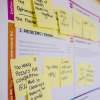In the digital world, first impressions count for a lot. Nowadays, we have a high expectation of not just the usability, functionality, and responsiveness, but also the aesthetics of a site, app, or software.
Thus, when is your digital product or platform due for a redesign? There are varying answers to this, ranging from one year to only when something breaks. In this article, I will try to highlight the common scenarios when a redesign is needed, the best practices, and tips for a successful makeover.
The most important thing is to understand why you are doing it, because that will determine how good the project turns out. When I’m talking about a redesign, I’m not talking about a simple facelift with different style of icons or coloured CTA buttons. I’m talking about a redesign that could touch upon either the functionality, user flow, overall UI, or all of them.
8 Signs Your Digital Product Needs a Redesign
1. Your product’s UX/UI is inconsistent and complex
This could come from having too many changes without proper planning, making the product bloated, complicated to use, and inconsistent. There’s probably a lot of design debt too, which is all the UX flaws accumulated over time when you cut corners. A redesign would require rethinking from a clean slate, and would be a major project. But it would be absolutely worth it, to improve user satisfaction, attract new customers and compete in the market.
2. Your product reviews are tanking
Reviews from users, media and professional critics are generally bad, or average at best. There could be multiple reasons behind it. Maybe the product is complex, the UI is outdated, or it simply doesn’t function properly due to design and technical errors. Chances are, it is affecting your bottom line and growth. You’ll have to find out what exactly from user feedback in customer support before you plot your redesign project.
3. Your product metrics are short of target
There are two situations here. It’s either your metrics were never good from product launch, or the numbers have worsened over time due to multiple factors such as a new competitor, changing market trends, dwindling resources, or strategies. You’ll need to do something to improve your numbers such as retention rate, user growth, usage time, and conversion rates. This could be a clear signal that it’s time for a product redesign.
4. You’re going through a rebranding exercise
Whether it is a corporate or a product rebranding, this is the perfect opportunity to assess the need for a redesign. If everything is working fine in your product, and users are generally happy with it, then a redesign would not be a major undertaking. But if things are generally heading south, then it becomes necessary to rethink your product and rebrand it at the same time.
5. You’re pivoting the business or product
This happens quite often in business. You may be exploring a new target market, trying to appeal to a wider audience or launching your product in international markets. Startups are also prone to pivoting in the early years, which means you’re overhauling your product completely. This is definitely a solid case for a redesign. Or you could choose to scrap your product and start from scratch if it makes more sense financially, and you are nimble enough.
6. Your product design is outdated
In the fast-paced digital world, staying relevant is a necessity, not a luxury. Designs that were the norm 3 years ago, may not be the case today. Most users are digitally savvy, especially the younger demographics, and they demand a lot from your product. Your product is also the digital face of your business, and it’s crucial to make sure you make the best impression to stay competitive in the market.
7. You’re adding major new features or integration
A redesign is needed when you are changing the core UX flow and functionalities of your product due to new functionalities, or you’re reimagining existing ones. You could also be integrating your product with a new platform or another product in your business. I’ve also done plenty of projects for clients that are digitising their business to make it much more convenient for their customers to use the product.
8. You’re keeping up with technology requirements
This is usually due to a newly released operating system, browser or technologies that might break or slow down your product. Your product may also not be mobile optimised and you’re losing users because of it. You could take this opportunity to upgrade your product from a design and technical perspective, utilising the latest tools and technologies that could support your product.
Tips on how to best approach a product redesign
1. Understand the reason why
You need to get this right off the bat. There’s no point in redesigning if you aren’t clear about why you’re doing it and what you want to achieve. You’ll want to look at the current stats and feedback, and think of how you want to improve them. A redesign needs goals, and you shouldn’t be upgrading your product blindly because you think it’s time to jazz it up to outshine your competitors.
2. Conduct a UX/UI audit
A UX audit helps you to assess which user needs aren’t being met, identify design bugs and imperfections, conduct usability tests, study trends in user behaviour, and understand where the market is heading. You can take a step further and assess your UX team capabilities, the design strategies you’re using. and the processes that are potentially blocking a smooth design and development project.
3. Get non-designers involved
A redesign project isn’t just for designers, despite its name. You’ll require the participation of other stakeholders in the business, such as business analysts, developers, marketers, and customer service. When you’re redesigning, you’ll need everyone to give their input and get on board to ensure you’re covering all loopholes, and delivering a comprehensive redesign that will actually make a positive impact for the company.
4. Protect your metrics and assets
You don’t want a redesign project that takes away the wins you’ve already chalked up. Understand your SEO metrics, product metrics, and protect the high-performing areas of the product. In the worst-case scenario, your redesign might break a crucial user functionality that brings in a steady stream of revenue or leads. There’s a lot of work that goes into a redesign that must be thought of from day one, to ensure you’re actually adding value to users.
5. Maintain some predictability
It’s absolutely great if you’re taking design leaps but do remember that your most loyal customers and long-time users will expect something that is somewhat familiar to how they do things with your product. There should be some element of predictability in the UX flow and design that your users have grown used to. You don’t want to irk the bulk of your fans by introducing something radically different that puts them off using your product.
6. Iterate on your redesign
If this practice is something that’s already ingrained in your process, then great. If not, you’ll need to continually refine and improve your redesign because, hey, nothing works perfectly when you launch, right? Monitor the user feedback and stats, and always be proactive to spot problems before they snowball into major issues.







